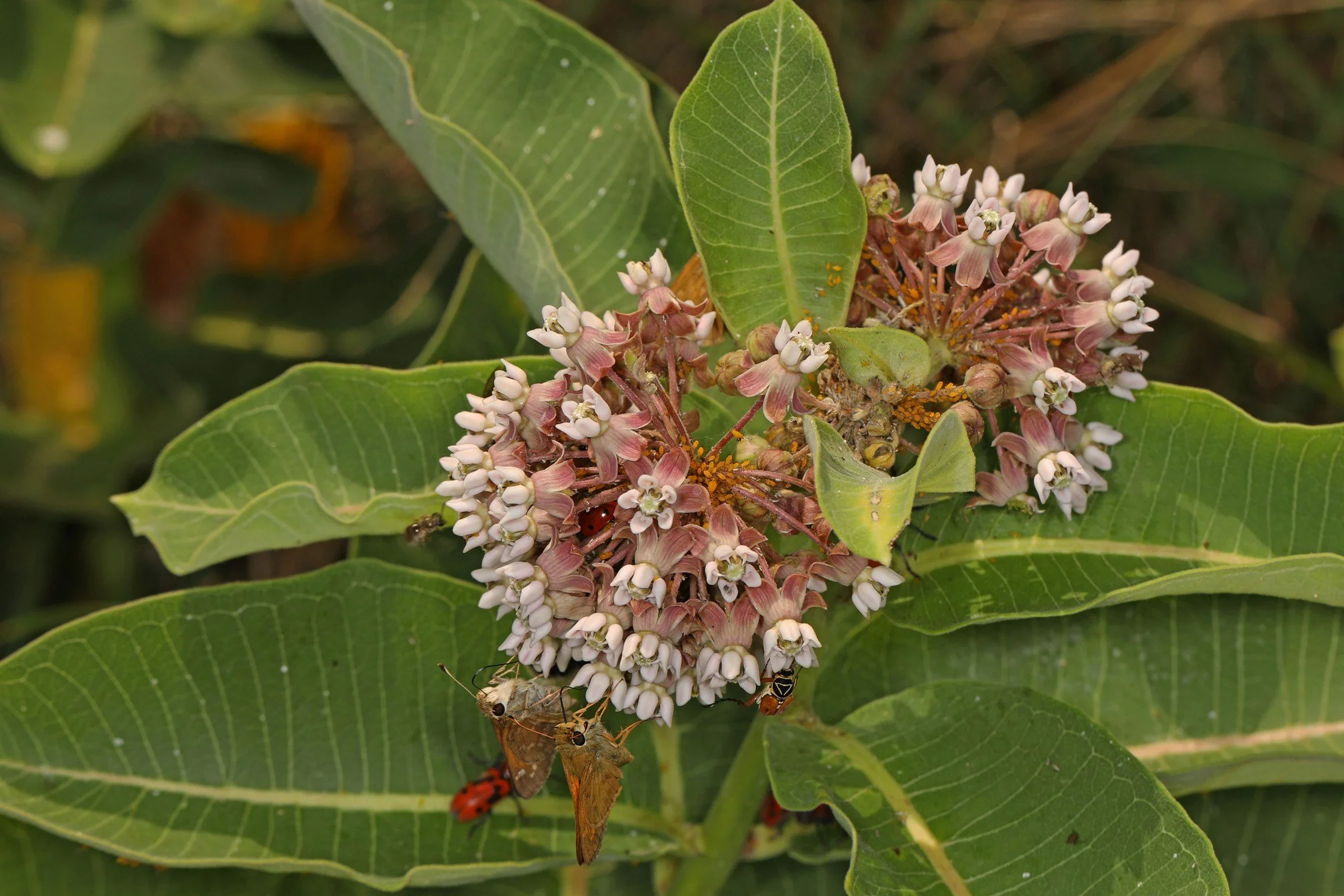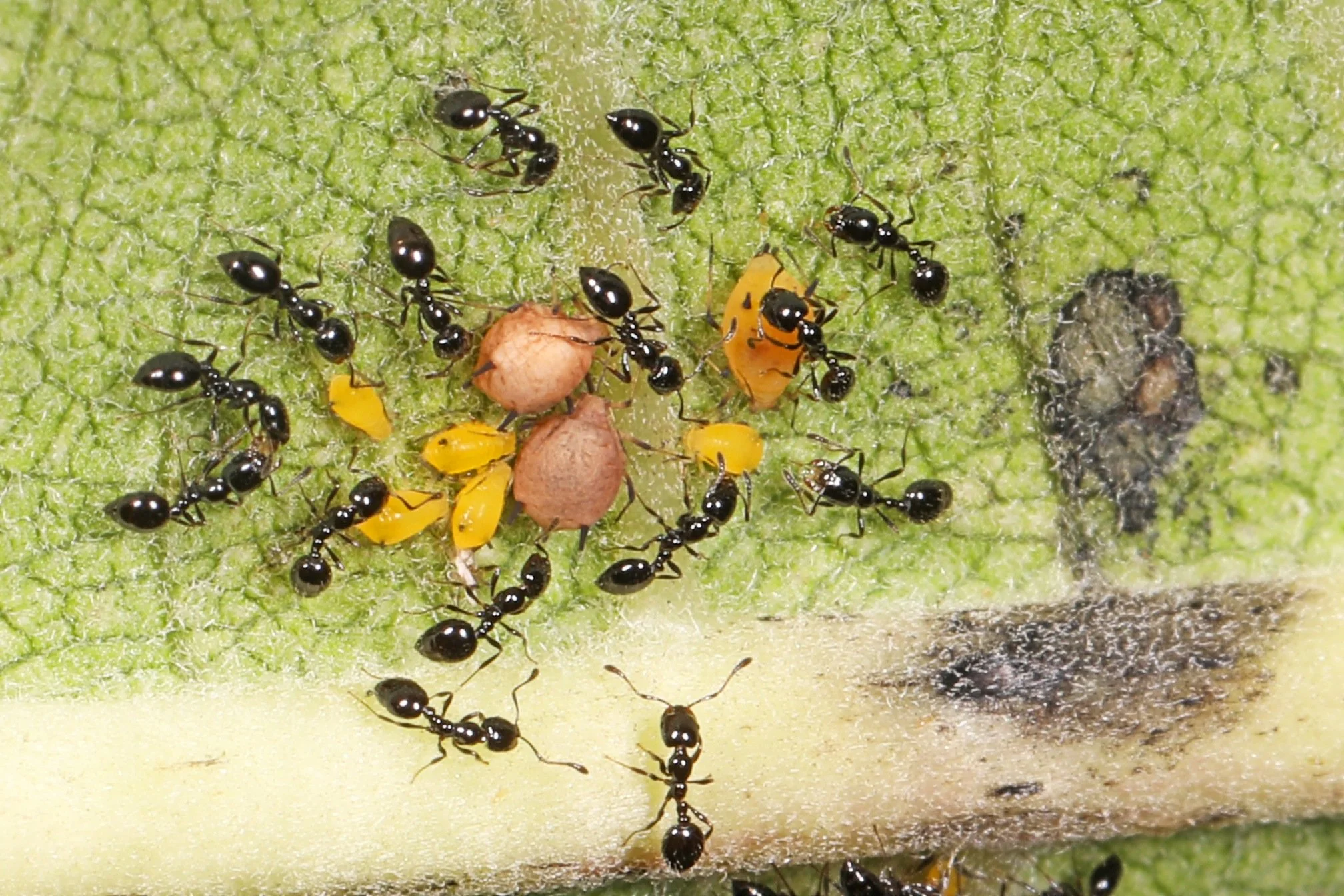Photo: Common Milkweed with multiple insects on flowers, Judy Gallagher
Judy Gallagher
July-August 2025
I am fascinated by the concept that plants and insects have co-evolved. Many plants rely on insects to pollinate them and disperse their seeds, and most insects rely on plants for food, either directly, or indirectly by eating other insects that have eaten plants. But it isn't in the plant's best interest to have all its vegetation eaten, and plants have evolved strategies to ensure that they survive the hordes of hungry insects.
Common Milkweed with multiple insects on flowers, including Sachem Skippers, Oleander Aphids, Delta Flower Scarab Beetle, Small Carpenter Bee and Seven-spotted Lady Beetle , Judy Gallagher
Members of the Milkweed family produce chemicals called cardenolides which are toxic to most invertebrates, thereby preventing them from eating Milkweed's foliage. But a few insects, including the Monarch butterfly caterpillar, Small and Large Milkweed Bugs, Milkweed Longhorn Beetles, Milkweed Stem Weevil, Milkweed Tussock Moth caterpillars, three aphid species, a leaf-mining fly and the Swamp Milkweed Beetle have developed a tolerance to these chemicals. Some of these insects eat the leaves, at least one eats the roots, and Milkweed Bugs eat the seeds. The ingested cardenolides then protect most of these insects from predation by birds and other vertebrates. Milkweed's toxins aren't found in the flowers, so most insects can dine on nectar and pollinate the plants without being affected.
Monarch caterpillars, Judy Gallagher
Although the insects mentioned above can eat Milkweed, Milkweed still has some defense against them. The undersides of Milkweed leaves are hairy, and these inedible hairs make it challenging for insects like newly hatched Monarch or Milkweed Tussock Moth caterpillars to access edible leaf tissue. The caterpillar must remove the hairs from an area of leaf before biting into the leaf, and many new caterpillars die of dehydration before they have removed enough hairs to get to the edible part of the leaf.
Milkweed Stem Weevil with mouthparts clogged with latex, Judy Gallagher
Up to 60% of the caterpillars that get this far die after their first bite of Milkweed, which has another defense mechanism of gummy white latex. If the latex isn’t removed quickly, it will seal an insect's mouth closed, preventing further feeding. Milkweed tolerant insects compensate for that by chewing through small sap-carrying veins, forming a trench around an area of leaf tissue. This cuts off the flow of sap into that part of the leaf, and the insect can eat without encountering latex.
Red Milkweed Beetle adult with latex on its head. Fortunately for it, the latex is not clogging its mouthparts. The beetle's bright color advertises that it is toxic. Judy Gallagher
Many Milkweed-tolerant insects are brightly colored. This is called aposematic coloring, and it advertises to predators like birds that the insect is unpalatable. Red Milkweed Beetle larvae burrow into the soil and feed on milkweed roots. Like the leaves, milkweed roots have toxic cardenolides; however, unlike the leaves, they aren’t protected by latex. But they do have another defense. When attacked, milkweed roots release volatile chemical compounds that attract soil-dwelling non-segmented worms called nematodes, which then prey upon the beetle larvae. Red Milkweed Beetle adults feed on Milkweed leaves and flowers.
Milkweed Leaf Beetle, Judy Gallagher
The Milkweed Leaf Beetle is sometimes found on Common Milkweed but more commonly on Swamp Milkweed. It can also process Milkweed’s toxic cardenolides but does not keep the toxins in its body. It is somewhat protected from predation by its warning coloration which resembles that of insects that are toxic.
Small Milkweed Bug eating another Small Milkweed Bug, Judy Gallagher
Large and Small Milkweed Bugs feed on Milkweed seeds, inserting their long proboscises into the seeds, injecting enzymes to liquefy the seeds' contents, and then sucking out the juice. The seeds have more cardenolides than the leaves, and both Milkweed Bugs sequester them and advertise their unpalatability with bright colors. Small Milkweed Bugs aren't as picky about their food as some other Milkweed-dependent insects. When Milkweed is scarce, they can also feed on Honey Bees, Monarch caterpillars and pupae, Large Milkweed Bugs, Dogbane Beetles, and each other.
Ants tending Aphids on Milkweed, Judy Gallagher
At least three aphid species feed on Milkweed. Some aphids are tended by ants, who like the sugary waste that aphids excrete. In exchange for the sugary waste, called honeydew, the ants protect the aphids from predation. But too many aphids could hurt the Milkweed plant, and it responds by producing more cardenolides. If the aphids' honeydew contains too high a concentration of cardenolides, ants won't eat it and won't protect the aphids. This tends to reduce the aphid population to a level that doesn't harm the Milkweed plant too much.
Nature is so complex! I hope you have a chance to observe insects on Milkweed this season.
View more of Judy’s articles on A Closer Look: Nature All Around Us (formerly Observations from Meadowood).







